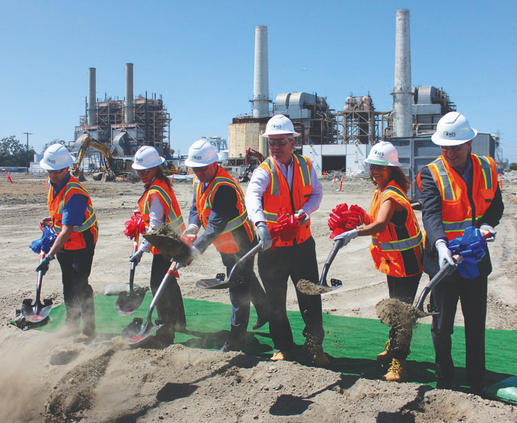A groundbreaking ceremony on July 21 marked the beginning of a $1.3 billion development project by AES Alamitos, a subsidiary of The AES Corporation, dubbed the Alamitos Energy Center (AEC). Upon completion of construction, the project calls for the demolition of the existing plant, including the 200-foot towers located off of Studebaker Road, beginning in 2021.
“Having the opportunity to be here, to reinvent this facility, is so important to me. We don’t just work here – we live here, we educate here, we’re raising our families here,” Jennifer Didlo, president of AES Southland, said during the event. “This is a very special project. I think other projects around California are connected to their community, but we are extra connected to this community.”

AES Alamitos celebrated the groundbreaking of a 640-megawatt natural gas-fired power plant and 100 megawatt battery energy storage system at 690 N. Studebaker Rd. in Southeast Long Beach on July 21. Pictured from left: Stephen O’Kane, president of AES Alamitos Energy, LLC; Jennifer Didlo, president AES Southland; Steve Berberich, president and CEO of California Independent System Operator; State Assemblyman Patrick O’Donnell; 3rd District Councilwoman Suzie Price; and Ken Zagzebski, president AES U.S. Strategic Business Unit. (Photograph by the Business Journal’s Brandon Richardson)
The new natural gas-fueled power plant is a replacement of the current plant, which has been in operation since the 1950s and provided more than 1 billion megawatt hours during that time. To avoid disruptions in service, the old plant will continue to operate until the new facility is complete.
After years of planning and review, the South Coast Air Quality Management District and the United States Environmental Protection Agency approved permits for the proposed project in April.
Initial construction is focused on one natural gas-fired, combined-cycle power block capable of generating 640 megawatts of power. This power block is scheduled to enter service during the first quarter of 2020. If AES acquires more power purchase agreements, an additional 400-megawatt power block would be constructed on the site, to begin operations late in 2022. If built to full capacity, the 1,040-megawatt facility would be capable of power about 1.5 million homes and businesses.
“This is going to be a tremendous asset for Southern California. It’s a long time coming,” Assemblyman Patrick O’Donnell said. “This long process is indicative of the fact that both AES and the California Energy Commission followed a very thorough, fair and transparent process that led to the approval of this AES project.”
O’Donnell said the plant will assist in helping California reach its ambitious environmental goals of cutting 50% of emissions by 2030. Additionally, he explained that the new plant would eliminate the use of ocean water and use 70% less fresh water for cooling purposes, which is in line with a regulation passed in 2010 by the State Water Resources Control Board.
In addition to generating power, the AEC project includes the construction of a 100-megawatt battery energy storage system, which allows for more integration of renewable energy sources such as wind and solar. AES and Edison have an agreement for the use of the energy storage, and if more agreements are made, AES will construct two more 100-megawatt storage systems. The system is up for approval by the Long Beach Planning Commission at its August 3 meeting.
“California is going through a major transition. We have about 10,000 megawatts of solar producing right now. We have several hundred megawatts of wind producing right now. Geothermal and all kinds of other renewables [are] on the grid,” Steve Berberich, president and chief executive officer of California Independent System Operator (ISO), said. “Over 67% of the energy being used is from renewables here in California – a truly remarkable thing for the sixth, rapidly becoming the fifth, largest economy in the world.”
According to Berberich, ISO controls about 80% of the high-voltage energy grid in California, which equates to about $9 billion of power that is traded back and forth. He explained that the energy storage system allows for renewable energy to be collected and stored to be used when the wind isn’t blowing and the sun isn’t shining. This allows for power plants to be used less often, thereby cutting more emissions and leaving a smaller footprint.
The new power plant will be able to begin and stop operations in minutes rather than hours, Berberich explained, which allows for renewables to be better utilized. Because it will not take as long to start the plant back up if needed, there is less hesitation to shut down the plant when renewables are strong.
Third District Councilmember Suzie Price said her primary focus was on identifying potential impacts on the community and how to mitigate them. AES was a great community partner and provided much-appreciated community outreach, according to Price.
“I’m very happy to report that based on the conclusion of numerous experts, there are no impacts which will be unmitigated as a result of this project. That’s a really big deal for the community that lives in the immediate vicinity,” Price said. “They are a part of our culture, and they are looking for ways to help mitigate any concerns that we all have, which is really all you can ask for as a city leader.”
